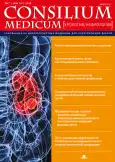Роботизированные технологии в урологии
- Авторы: Говоров А.В1, Васильев А.О1, Колонтарев К.Б1, Пушкарь Д.Ю1
-
Учреждения:
- ГБОУ ВПО МГМСУ им. А.И.Евдокимова Минздрава России
- Выпуск: Том 16, № 7 (2014)
- Страницы: 5-7
- Раздел: Статьи
- URL: https://journals.rcsi.science/2075-1753/article/view/94081
- ID: 94081
Цитировать
Полный текст
Аннотация
Полный текст
Открыть статью на сайте журналаОб авторах
А. В Говоров
ГБОУ ВПО МГМСУ им. А.И.Евдокимова Минздрава РоссииКафедра урологии
А. О Васильев
ГБОУ ВПО МГМСУ им. А.И.Евдокимова Минздрава РоссииКафедра урологии
К. Б Колонтарев
ГБОУ ВПО МГМСУ им. А.И.Евдокимова Минздрава РоссииКафедра урологии
Д. Ю Пушкарь
ГБОУ ВПО МГМСУ им. А.И.Евдокимова Минздрава РоссииКафедра урологии
Список литературы
- Arnold M, Karim-Kos H.E, Coebergh J.W et al. Recent trends in incidence of five common cancers in 26 European countries since 1988: Analysis of the European Cancer Observatory. Eur J Cancer 2013. pii: S0959-8049(13)00842-3. doi: 10.1016/j.ejca.2013.09.002. [Epubahead of print].
- Cooperberg M.R, Lubeck D.P, Mehta S.S et al. Time trends in clinical risk stratification for prostate cancer: implications for outcomes (data from CaPSURE). J Urol 2003; 170: 21-5; discussion 26-7.
- Walsh P.C, Donker P.J. Impotence following radical prostatectomy: insight into etiology and prevention. J Urol 1982; 128: 492-7.
- Millin T. Retropubic prostatectomy: a new extravesical technique report on 20 cases. 1945. J Urol 2002; 167: 976-9; discussion 980.
- Mottet N (chair), Bastian P.J, Bellmunt J et al. EAU Guidelines on Prostate Cancer. 2014; p. 57-67.
- Menon M, Tewari A, Peabody J.O. Vattikuti Institute prostatectomy, a technique of robotic radical prostatectomy for management of localized carcinoma of the prostate: experience of over 1100 cases. Urol Clin North Am 2004; 31: 701-17.
- Intuitive Surgical®, Inc., intuitivesurgical.com. 2010. Annual Report.
- Gainsburg D.M, Wax D, Reich D.L et al. Intraoperative management of robotic - assisted versus open radical prostatectomy. J Soc Laparoend 2010; 14: 1-5.
- Kordan Y, Barocas D.A, Altamar H.O et al. Comparison of transfusion requirements between open and robotic - assisted laparoscopic radical prostatectomy. Br J Urol Int 2010; 106: 1036-40.
- Rocco B, Matei D.V, Melegari S et al. Robotic vs open prostatectomy in a laparoscopically naive centre: a matched - pair analysis. Br J Urol Int 2009; 104: 991-5.
- Truesdale M.D, Lee D.J, Cheetham P.J et al. Assessment of lymph node yield after pelvic lymph node dissection in men with prostate cancer: a comparison between robot - assisted radical prostatectomy and open radical prostatectomy in the modern era. J Endourol 2010; 24: 1055-60.
- Bolenz C, Gupta A, Hotze T et al. Cost comparison of robotic, laparoscopic, and open radical prostatectomy for prostate cancer. Eur Urol 2010; 57: 453-8.
- Lo K.L, Ng C.F, Lam C.N et al. Short - term outcome of patients with robot - assisted versus open radical prostatectomy: for localised carcinoma of prostate. Hong Kong Med J 2010; 16: 31-5.
- Carlsson S, Nilsson A.E, Schumacher M.C et al. Surgery - related complications in 1253 robot - assisted and 485 open retropubic radical prostatectomies at the Karolinska University Hospital, Sweden. J Urol 2010; 75: 1092-7.
- Lowrance W.T, Elkin E.B, Jacks L.M et al. Comparative effectiveness of prostate cancer surgical treatments: a population based analysis of postoperative outcomes. J Urol 2010; 183: 1366-72.
- Ficarra V, Novara G, Fracalanza S et al. A prospective, non - randomized trial comparing robot - assisted laparoscopic and retropubic radical prostatectomy in one European institution. Br J Urol Int 2009; 104: 534-9.
- Di Pierro G.B, Baumeister P, Stucki P et al. A prospective trial comparing consecutive series of open retropubic and robot - assisted laparoscopic radical prostatectomy in a centre with a limited case - load. Eur Urol 2011; 59 (1): 1-6.
- Hu J.C, Gu X, Lipsitz S.R et al. Comparative effectiveness of minimally invasive vs open radical prostatectomy. J Am Med Assoc 2009; 302: 1557-64.
- Pfitzenmaier J, Pahernik S, Tremmel T et al. Positive surgical margins after radical prostatectomy: do they have an impact on biochemical or clinical progression? Br J Urol Int 2008; 102: 1413-8.
- Ficarra V, Novara G, Artibani W et al. Retropubic, laparoscopic, and robot - assisted radical prostatectomy: a systematic review and cumulative analysis of comparative studies. Eur Urol 2009; 55: 1037-63.
- Krambeck A.E, Di Marco D.S, Rangel L.J et al. Radical prostatectomy for prostatic adenocarcinoma: a matched comparison of open retropubic and robot - assisted techniques. Br J Urol Int 2009; 103: 448-53.
- Barocas D.A, Salem S, Kordan Y et al. Robotic assisted laparoscopic prostatectomy versus radical retropubic prostatectomy for clinically localized prostate cancer: comparison of short - term biochemical recurrence - free survival. J Urol 2010; 183: 990-6.
- Choi W.W, Gu X, Lipsitz S.R et al. The effect of minimally invasive and open radical prostatectomy surgeon volume. Urol Oncol 2012; 30 (5): 569-76.
- Coelho R.F, Rocco B, Patel M.B et al. Retropubic, laparoscopic, and robot - assisted radical prostatectomy: a critical review of outcomes reported by high - volume centers. J Endourol 2010; 24: 2003-15.
- Malcolm J.B, Fabrizio M.D, Barone B.B et al. Quality of life after open or robotic prostatectomy, cryoablation or brachytherapy for localized prostate cancer. J Urol 2010; 183: 1822-8.
- Thorsteinsdottir T et al. LAPPRO: a prospective multicentre comparative study of robot - assisted laparoscopic and retropubic radical prostatectomy for prostate cancer. Scand J Urol Nephrol 2011; 45 (2): 102-12. Epub 2010 Nov 29.
- Wilson T, Torrey R. Open versus robotic - assisted radical prostatectomy: which is better? Curr Opin Urol 2011; 21 (3): 200-5.
- Kim S.C et al. Factors determining functional outcomes after radical prostatectomy: robot - assisted versus retropubic. Eur Urol 2011; 60 (3): 413-9.
- Meyer E.K, Winkler M.H, Aggarwal R et al. Robotic prostatectomy: the first UK experience. Int J Med Robot 2006; 2 (4): 321-8.
Дополнительные файлы






